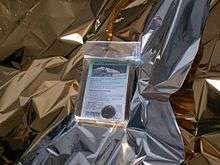Space blanket
A space blanket (also known as a Mylar blanket, emergency blanket, first aid blanket, safety blanket, thermal blanket, weather blanket, heat sheet, or shock blanket) is an especially low-weight, low-bulk blanket made of heat-reflective thin plastic sheeting. They are used on the exterior surfaces of spacecraft for thermal control, as well as by people. Their design reduces the heat loss in a person's body, which would otherwise occur due to thermal radiation, water evaporation, or convection. Their compact size before unfurling and light weight makes them ideal when space or weight are at a premium. They may be included in first aid kits and also in camping equipment. Lost campers and hikers have an additional possible benefit: the metallic surface appearance flashes in the sun, allowing use as an improvised distress beacon for searchers and also as a method of signalling over long distances to other people on the same route.[1]

Manufacturing

First developed by NASA's Marshall Space Flight Center in 1964 for the US space program,[2][3][4] the material consists of a thin sheet of plastic (often PET film) that is coated with a metallic reflecting agent, making it metallized polyethylene terephthalate (MPET), usually gold or silver in colour, which reflects up to 97% of radiated heat.[5][6]
For use in space, polyimide (e.g. kapton, UPILEX) substrate is usually employed due to its resistance to the hostile space environment, large temperature range (cryogenic to −260 °C and for short excursions up to over 480 °C), low outgassing (making it suitable for vacuum use) and resistance to ultraviolet radiation. Aluminized kapton, with foil thickness of 50 and 125 µm, was used e.g. on the Apollo Lunar Module.[7] The polyimide gives the foils their distinctive amber-gold color.
Space blankets are made by vacuum-depositing a very precise amount of pure aluminum vapor onto a very thin, durable film substrate.[8]
Usage
.jpg)
.jpg)
In their principal usage, space blankets are included in many emergency, first aid, and survival kits because they are usually waterproof and windproof. That, along with their low weight and ability to pack into a small space, has made them popular among outdoor enthusiasts and emergency workers. Space blankets are often given to marathoners and other endurance athletes at the end of races, or while waiting before races if the weather is chilly.[9] The material may be used in conjunction with conductive insulation material and may be formed into a bag for use as a bivouac sack (survival bag).[10][11]
In first aid,[12] the blankets are used to prevent/counter hypothermia. A threefold action facilitates this:
- The airtight foil reduces convection
- Heat loss caused by evaporation of perspiration is reduced[13]
- To a limited extent the reflective surface inhibits losses caused by thermal radiation.
In a hot environment they can be used to provide shade or provide protection against radiated heat, but using them to wrap a person would be counterproductive, because body heat would get trapped by the airtight foil. This effect would exceed any benefit gained from heat reflection to the outside.
Space blankets are used to reduce heat loss from a person's body, but as they are constructed of PET film, they can be used for other applications for which this material is useful, such as insulating containers—e.g. for DIY solar projects—and other applications.
In addition to the space blanket, the United States military also uses a similar blanket called the "casualty blanket". It uses a thermal reflective layer similar to the space blanket, backed by an olive drab colored reinforcing outer layer. It provides greater durability and warmth than a basic space blanket at the cost of greater bulk and weight. It is also used as a partial liner inside the layers of bivouac sacks in very cold weather climates.[14] Space blankets are also used by the Taliban to hide their heat signature from NATO forces.[15][16]
See also
- Thin-film deposition
- Thermoregulation
- Emissivity
- Thermal insulation
- Radiant barrier
- Reflectivity
- R-value (insulation)
- Emergency shelter
References
- "How Space Blankets Work". howstuffworks.com. 24 November 2009. Retrieved 14 September 2018.
- Hall, Loura (15 September 2016). ""Reflecting on Space Benefits: A Shining Example."". NASA Center for AeroSpace Information. Retrieved 14 September 2018.
- Huntington, Tom. "Bringing NASA Down to Earth." AmericanHeritage.com. 2008.
- Bryan, Will (May 11, 2016). "The Space Blanket: Your Adventure Companion". The Marshall Star. NASA. Retrieved May 11, 2016.
- Reflective Insulation Test data.
- Speik, Robert. "Emergency space blankets provide a false sense of security". traditionalmountaineering.org. Retrieved 14 September 2018.
- Paul Fjeld. "Lunar Module Coatings". home.earthlink.net. Retrieved 14 September 2018.
- "Space Blankets". Retrieved 12 March 2016.
- "General Guidelines for Recycling at Mass Participant Sporting Events." AFMInc. 2008.
- "Emergency Shelter" REI.
- "Full Wrap on Space Blankets." Runner's World. 2005.
- Buggy, D.; Hughes, N. (1 April 1994). "Pre-emptive use of the space blanket reduces shivering after general anaesthesia". British Journal of Anaesthesia. 72 (4): 393–396. doi:10.1093/bja/72.4.393. Retrieved 14 September 2018.
- "How Body Heat is Lost." Survival Topics.
- "How to Choose Bivy Sacks". REI. Retrieved 14 September 2018.
- "Afghanistan: Patrolling the most attacked base". BBC. 5 December 2011. Retrieved 5 December 2011.
- Smucker, Philip. "U.S. soldiers' options limited to protect Afghans from Taliban." The State. Jun. 2, 2009.